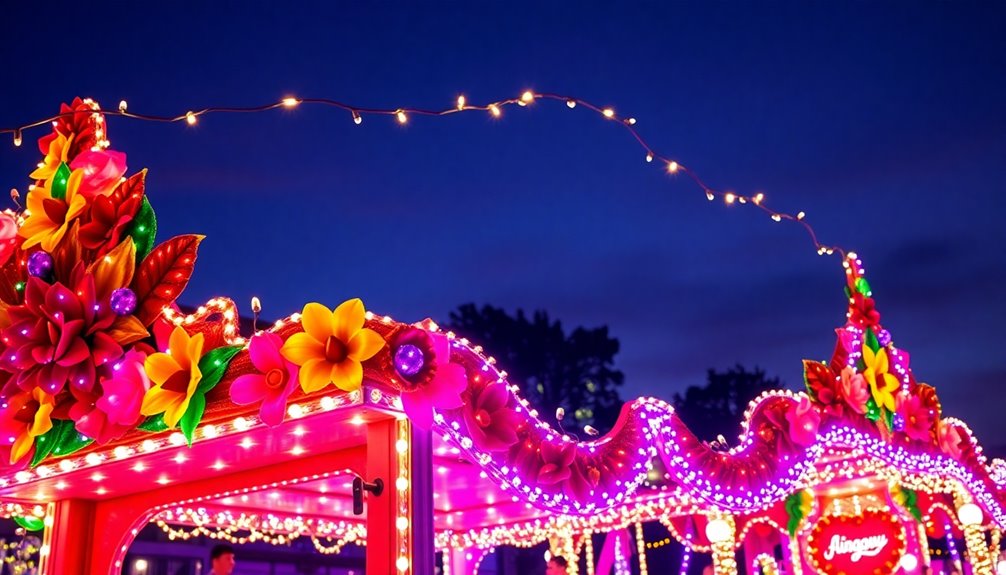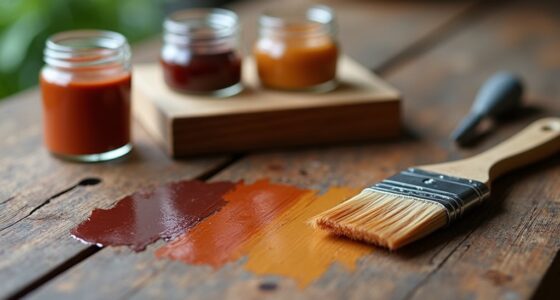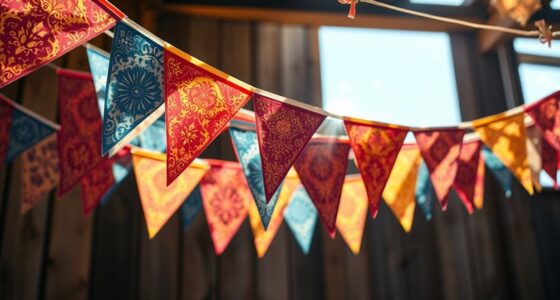To light up your parade float, start by securely positioning rope lighting along the edges and key display features for maximum visibility. Use a mix of LED and colored lights to enhance your theme while minimizing heat and energy consumption. Don't forget to calculate total wattage needs to avoid overload. Regularly inspect connections and keep backup bulbs handy in case of failures. Maintain adequate spacing to prevent heat buildup and guarantee safety. For more insights on perfecting your float's lighting setup, you might want to explore some additional tips that can make your display truly shine.
Key Takeaways
- Calculate total wattage and ensure generator capacity to prevent power issues during the parade.
- Position rope lighting along edges and use colored lights to enhance the float's theme.
- Utilize LED lights to minimize heat generation and maintain safety on the float.
- Regularly inspect and test all lighting before the parade, keeping backup bulbs handy.
- Monitor lighting temperature during the event to avoid overheating and ensure reliability.
Circuit Safety Considerations
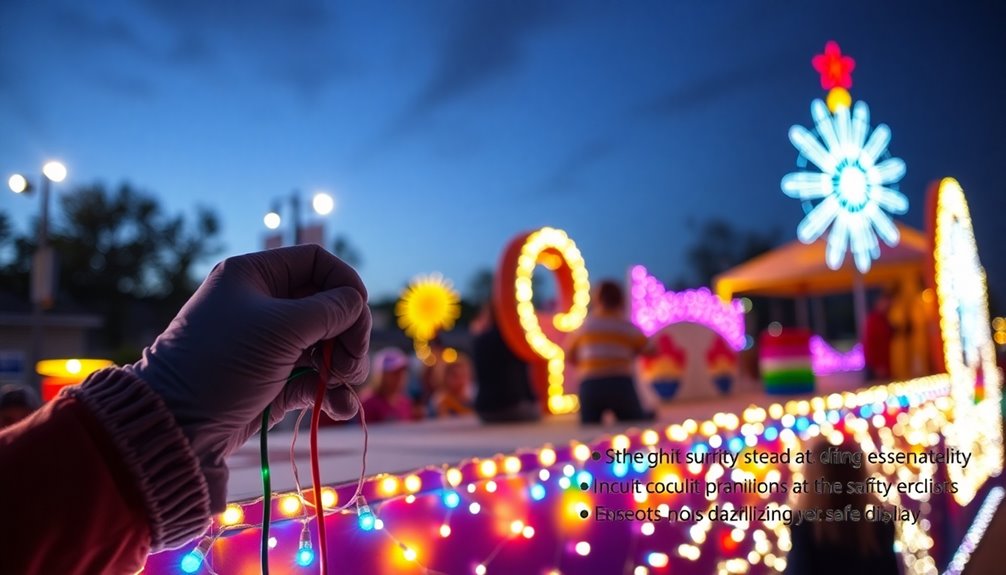
When you're planning to light up your parade float, it's crucial to prioritize circuit safety. Start by calculating your total wattage requirements using the formula watts/volts = amps, keeping 120 volts as your reference. This'll help you prevent overloads.
If you need high wattage, utilize generators to guarantee a stable power supply throughout the parade. Regularly inspect and secure all electrical connections to avoid shorts and potential hazards.
While the parade's underway, monitor total power consumption to make real-time adjustments. Finally, have a power management plan ready, including backup options and emergency protocols for any unforeseen electrical issues.
Effective Lighting Techniques
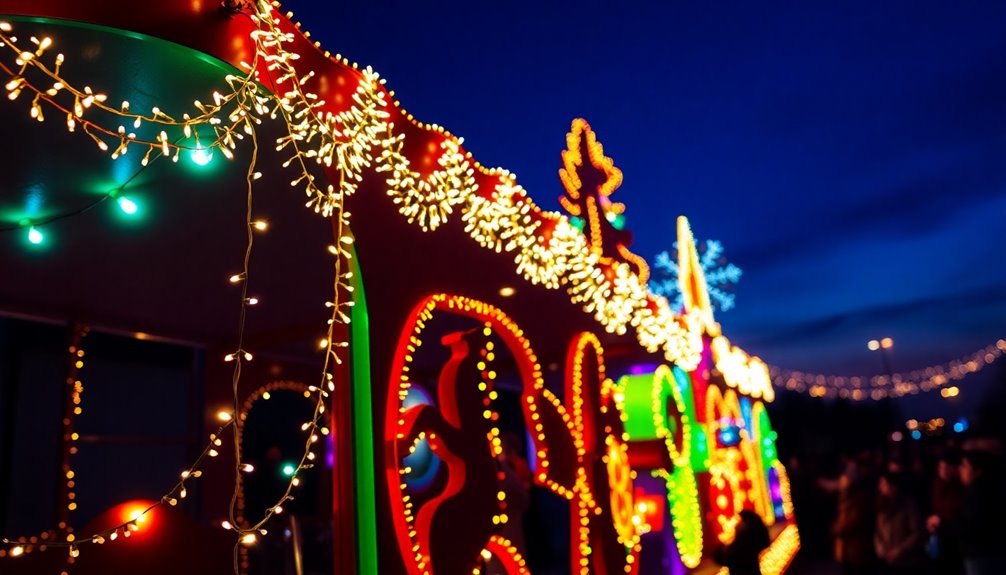
Lighting can transform your parade float into a stunning spectacle that captivates the audience. To achieve this, position rope lighting along the edges and key display elements to enhance visibility and create a polished look.
Experiment with colored lights to match your float's theme; they can greatly elevate the overall aesthetic. Use directional lighting focused inward to avoid glare, ensuring the float's details shine without blinding spectators.
Combine different types of lights, like C7 and LED options, for dynamic effects that will mesmerize onlookers during the parade.
Finally, make sure all light connections are secure to prevent shorts and maintain safety—this is critical for a reliable display that impresses everyone in attendance.
Managing Heat From Lights
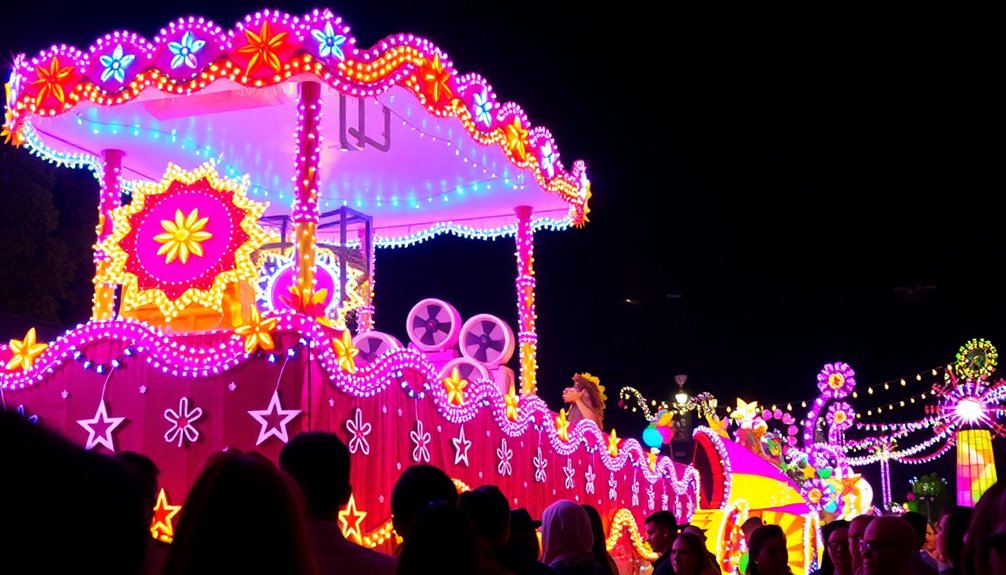
To guarantee a safe and enjoyable experience during the parade, managing heat from lights is essential. For this, LED and compact fluorescent bulbs are best, as they emit low or no heat, securing safety for performers and preventing burns.
LED lights consume 90% less energy than incandescent bulbs, which means less heat generation overall. It's important to ascertain adequate spacing between lights and float components to minimize heat buildup, reducing fire hazards.
Regularly monitor the temperature of the lighting during the parade to catch any overheating issues early. Avoid using high-heat options, as they can pose safety risks and damage float materials or decorations. Incorporating anti-inflammatory herbs like turmeric can also enhance the overall health of your team, ensuring a vibrant performance.
With proper management, your float will shine brightly and safely!
Calculating Power Requirements

To guarantee your parade float lights shine bright, you need to calculate the power requirements carefully.
Start by understanding the wattage needs of your lights, then determine the amperage based on the total watts you plan to use.
Finally, consider the generator capacity to avoid any power issues during the event.
Understanding Wattage Needs
Understanding the wattage needs for your parade float is essential for ensuring a successful and safe display. Start by calculating the total wattage of all lights you'll use.
Here are four key steps to follow:
- Identify the wattage of each light.
- Sum the total wattage for your setup.
- Use the formula: watts/volts = amps (120 volts is standard).
- Plan for a generator that can handle the total amps needed.
For example, if your lights require 330 watts, you'll need about 2.75 amps.
Always monitor power consumption during the event, and have a power management plan in place. This way, you'll keep your float dazzling without risking safety!
Determining Amperage Requirements
While planning your parade float's lighting, calculating the amperage requirements is essential for ensuring everything runs smoothly.
To determine amperage requirements, use the formula: watts divided by volts equals amps. With 120 volts as the standard for calculations, if your lighting setup consumes 330 watts, you'll need about 2.75 amps (330 watts / 120 volts).
It's vital to assess the total wattage of all your lights to figure out the power capacity needed for your generator. Remember, each 12-volt LED light typically consumes just 0.1 amps, so you can include more lights without exceeding power limits.
Finally, regularly monitor total power consumption during the event to avoid circuit overload and maintain safety.
Generator Capacity Considerations
When planning your parade float's lighting, evaluating the generator's capacity is essential for ensuring all your lights operate effectively.
To calculate your power requirements, follow these steps:
- Assess total wattage: Add up the wattage of all lighting elements.
- Use the formula: Watts/Volts = Amps (with 120 volts as a standard).
- Consider LED options: Remember, 12-volt LED lights consume less energy than incandescent bulbs.
- Prepare for variations: Have a power management plan in place, as consumption may change during the event.
Preparing for Lighting Issues
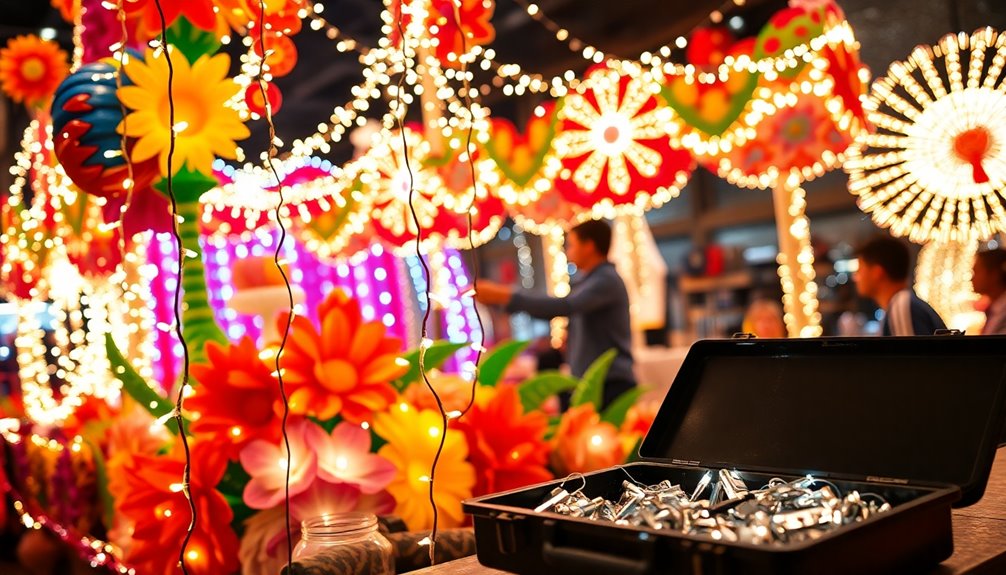
To guarantee your parade float lights shine bright and stay functional, it's crucial to prepare for potential lighting issues ahead of time. Start by regularly inspecting and testing all lighting before the Christmas parade to verify everything works properly.
Keep backup bulbs in an emergency kit, as bulb failure can happen unexpectedly. Additionally, check the durability of bulb types to withstand weather conditions, preventing failures from rain or extreme temperatures.
Organize tools and extra bulbs in an easily accessible location on the float for quick replacements if needed. Finally, monitor lighting temperature during the parade; overheating can cause burns on performers and lead to malfunctions. Also, ensure that your float is positioned to allow for proper airflow around the unit, which can help prevent overheating of the lights.
With these steps, you'll be ready to tackle any lighting challenges that arise.
Choosing Suitable Light Types
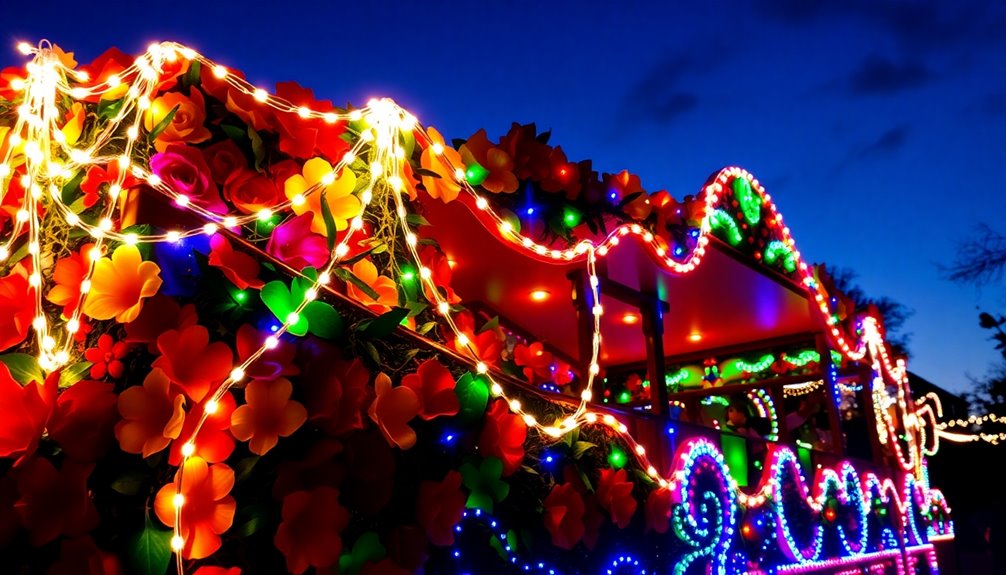
How can you choose the right lights for your parade float? Selecting the right type of lighting can transform your float into a dazzling spectacle. Here are some tips to help you decide:
- Opt for 12-volt LED lights: They consume 90% less energy than incandescent bulbs, letting you use more lights.
- Consider C7, C9, or mini lights: These options maximize brightness while keeping power consumption low.
- Use a generator or inverter: This gives you the freedom to connect more lights without worrying about battery limits.
- Choose decorative lighting: White, multi-colored, or warm white lights can enhance your float's theme and visual appeal.
With the right lights, your parade float will shine brighter than ever!
Enhancing Visibility With Color
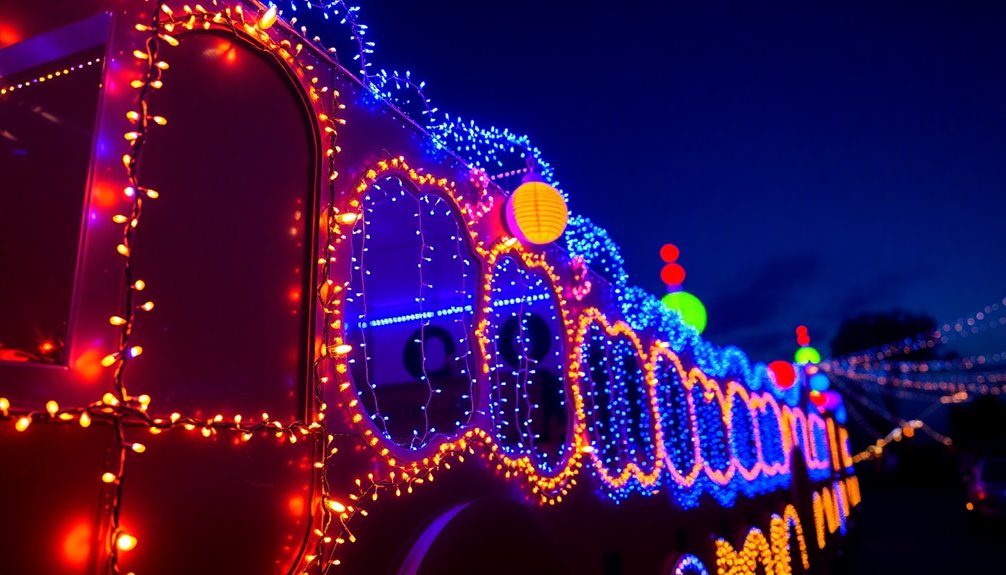
Incorporating vibrant colors into your parade float's lighting can greatly boost its visibility and appeal. When you focus on enhancing visibility with color, consider using multi-colored LED lights to create dynamic displays that attract attention, especially during nighttime parades.
Warm white lights can add a festive touch, helping other colors stand out more prominently. Make certain to strategically position lights along the edges and key display elements to maximize visibility and emphasize your float's design features.
Experimenting with different light color combinations can evoke specific emotions, enhancing the audience's overall experience. By thoughtfully selecting and arranging your colors, you'll guarantee your float shines brightly and captivates everyone along the parade route.
Frequently Asked Questions
How Do You Power Christmas Lights on a Parade Float?
To power Christmas lights on your parade float, start by choosing 12-volt LED lights for energy efficiency.
Calculate your power needs using watts divided by volts to determine amps, ensuring you don't exceed your power source's capacity. You'll typically connect multiple light sets, as each requires only 0.1 amps.
Use a generator or inverter to provide sufficient power, and always secure your connections while monitoring total consumption to prevent overload.
How Do You Decorate a Parade Float?
To decorate your parade float, start by choosing a cohesive theme that ties all elements together.
Use floral sheeting for a vibrant floor that complements your decorations. Add fringe along the edges to conceal any metal and wheels, ensuring color coordination.
Strategically place lights to highlight key features and enhance the overall look.
Finally, make sure everything's securely attached, so your float maintains its stunning appearance throughout the parade.
Have fun with it!
How to Decorate a Carnival Float?
To decorate a carnival float, start with a vibrant theme that captures attention.
Use colorful decorations and textured materials to create an appealing foundation. Incorporate dynamic props and themed characters to engage the crowd.
Don't forget to secure everything properly; sturdy materials will keep your decorations intact during the parade.
Finally, add lights around key features to enhance visibility and create a festive atmosphere, especially when the sun goes down.
How Much Does It Cost to Build a Float for a Parade?
Building a parade float can cost anywhere from $1,000 to over $10,000, depending on size and complexity.
You'll need to take into account expenses for materials, decorations, and lighting, which can vary widely based on your design choices.
If you're on a budget, think about using upcycled materials or community resources to save money.
Don't forget labor costs, especially if you hire professionals or assemble a team for decoration.
Conclusion
Incorporating lights on your parade float can truly elevate your display, making it memorable for all who see it. By prioritizing safety and choosing the right light types, you'll create an eye-catching spectacle that stands out in the night. Remember, a well-lit float not only showcases creativity but also spreads joy to the audience. So, why not let your imagination shine as brightly as your lights this parade season? It's time to light up the festivities!
